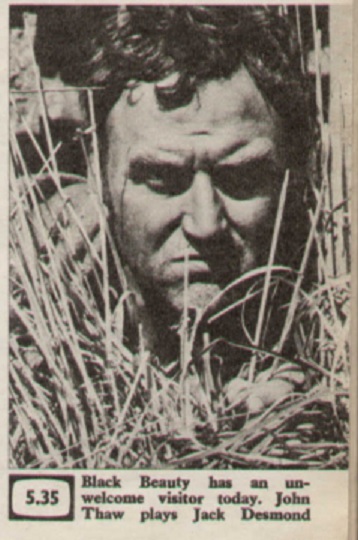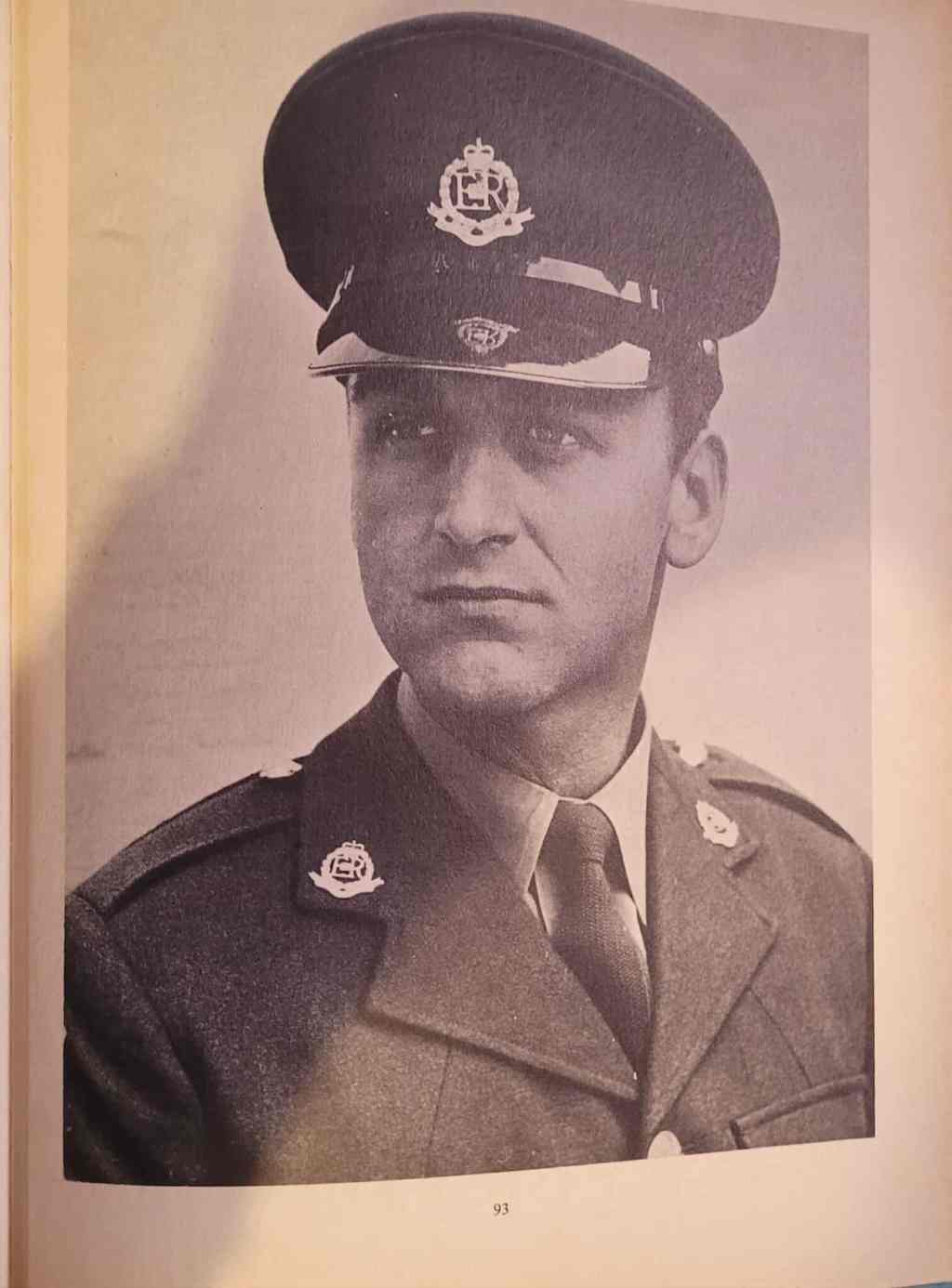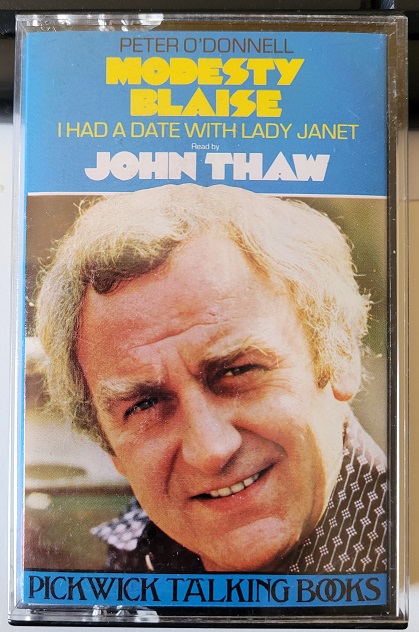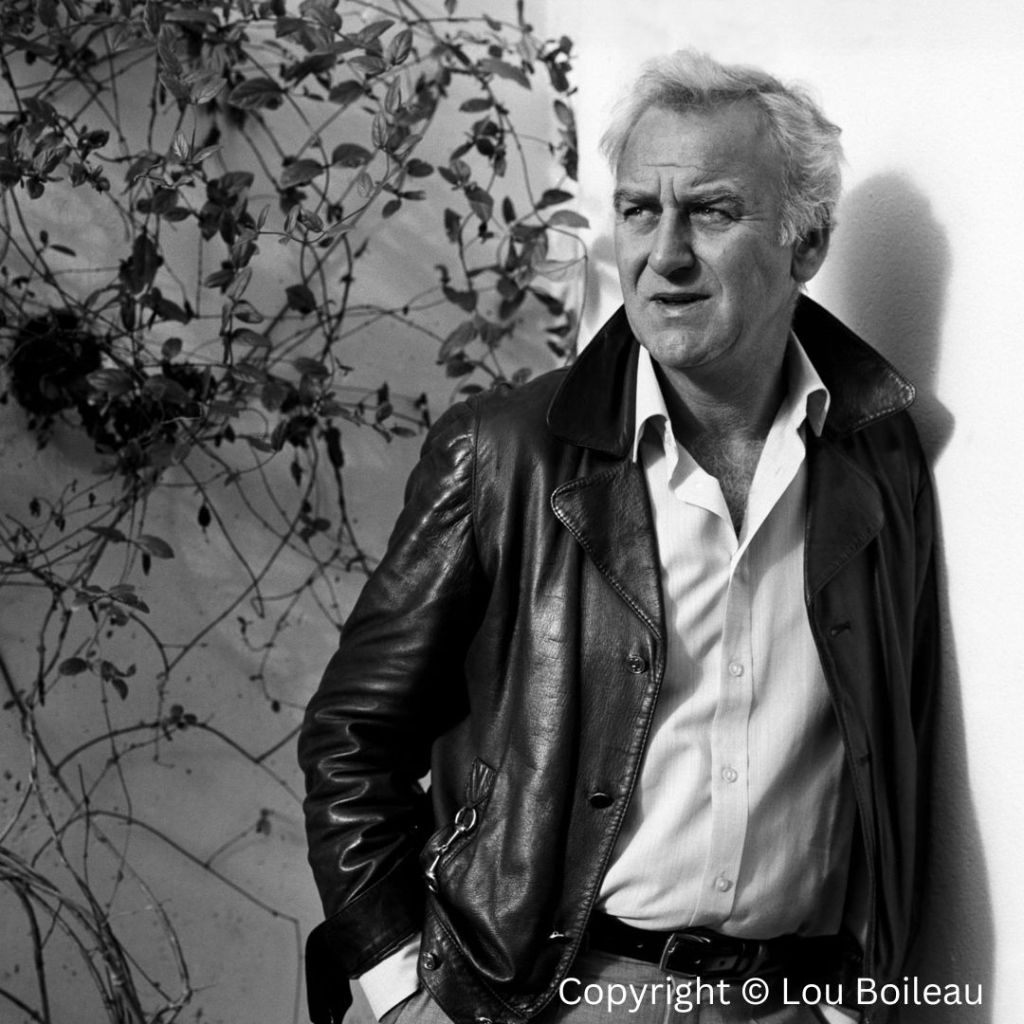In The Two of Us (2004), Sheila Hancock remembers John being around at home more once the heavy filming schedule of The Sweeney was behind him. Time at home included barbecues spent with friends and neighbours Richard Briers and family (p. 180). Things soon became busier! The 1980s was to be another decade of terrific career development for John, including film work and his first BAFTA nomination for Cry Freedom (1987), a season with the RSC, and of course the start of the series for which he is best remembered: Inspector Morse.
John and Sheila, 1980.
1980
In January 1980, John Thaw could be seen on BBC Two reading a series of short stories by F. Scott Fitzgerald. The short series, entitled Hollywood and Vine ran for four days between 14th and 18th January, screened around 11pm. The four short stories featured F. Scott Fitzgerald’s Hollywood screenwriter character Pat Hobby.
In the spring of this year, John set sail from Plymouth to film Drake’s Venture, a television film by Westward Television about Sir Francis Drake’s around-the-world voyage. (In fact, they did not travel very far away from the Devon coast!). A wave of articles, interviews and photographs were given to the press ahead of the film’s release, however, it seemed the publicity material drowned out the film itself! It was broadcast on 28 December 1980, and although a well-acted, quality piece, it sank in the ratings. It has not been repeated apart from its US release on Masterpiece Theatre in 1983.
John in Drake’s Venture (1980).
1981
John presented the BBC documentary series When the Bough Breaks, a series of ten informative programmes for parents who were concerned about how they treated their children, aiming to offer information, advice and resources. It was first broadcast on BBC Two on weekday evenings from Monday 5 January to Friday 16 January.
The theatrical film The Grass is Singing was first shown in May this year at the Cannes Film Festival. An adaptation of Doris Lessing’s 1950 novel of the same name, it starred John as a struggling South Rhodesian farmer, whom leading lady Karen Black’s character agrees to marry in order to stave off spinsterhood. A tale of tragedy and racial politics, the film was made on location in Zambia. John did not enjoy the three months spent on the project. Whilst a stream of difficulties set back filming, John suffered from such homesickness that he came close to abandoning the project and flying home. His acting in the finished production, however, is superb; one of the finest examples of his ability. The film was released in the UK and US the following year.
On 12 March 1981, John had just finished a meeting at The National Theatre to discuss an upcoming stage production of Serjeant Musgrave’s Dance when he was surprised by Eamonn Andrews and asked to be the subject of This Is Your Life. Having already taken part in Sheila Hancock’s and Dennis Waterman’s tributes, he was no stranger to the format, however, he was uncomfortable at finding himself the focus of the attention this time. He took part in the programme graciously, which was broadcast a few days later on Wednesday 18 March 1981.
John at home, 1980.
Serjeant Musgrave’s Dance by the National Theatre opened at the Cottesloe Theatre on 27 May, with John starring in the title role. This was the second time he had appeared in this play, the first being the Granada Television production twenty years earlier, in 1961, in which he had played Private Hurst. John’s performance as Serjeant Musgrave earned him excellent reviews from newspaper critics, as well as a positive reception from audiences. The play ran until September.
1982
Around this time, John recorded an audio tape for Pickwick Talking Books. Modesty Blaise: I Had a Date With Lady Janet was a short story by Peter O’Donnell featuring his action heroine, Modesty Blaise. John reads the story in the voice of the narrator, Modesty’s right-hand man, Willie Garvin.
In September, John reprised his role of Serjeant Musgrave for a radio production of the play. It was broadcast on BBC Radio 4 as the week’s Monday Play.
In December, John appeared on television once more in the TV play Where is Betty Buchus? It was written by Roger Marshall, who had worked with John previously on several occasions including for The Sweeney. John played Jack Buchus, the prime suspect in the disappearance of his wife Betty. It was broadcast as part of the “Saturday Night Thriller” anthology.
Another project written by Roger Marshall was a television series entitled Mitch. It starred John as a tough but honourable crime reporter who took to heart the cases he investigated. Filmed in 1982, the series is an engaging and good quality piece of television. Sadly, due to budgeting problems and executive changes, the production company, London Weekend Television, did not show Mitch until two years later. Consequently only one series was filmed.
1983
In February, John could be heard narrating the second part of the Channel 4 documentary Jailed by the British, which examined the internment of Italian and German citizens in Britain during WW2. The documentary was produced and directed by Lavinia Warner.
John spent a season with the Royal Shakespeare Company (RSC), 1983 – 1984.
At Stratford, John played Nick, in William Saroyan’s The Time of Your Life, presented at The Other Place.
He appeared in Shakespeare’s Twelfth Night at the Royal Shakespeare Theatre from April, playing Sir Toby Belch.
In Henry VIII, he took the role of Cardinal Wolsey, bringing to the character an instinctive depth and realism drawn from his own understanding and life experiences rather than an academic study of Shakespeare. The play opened in June.
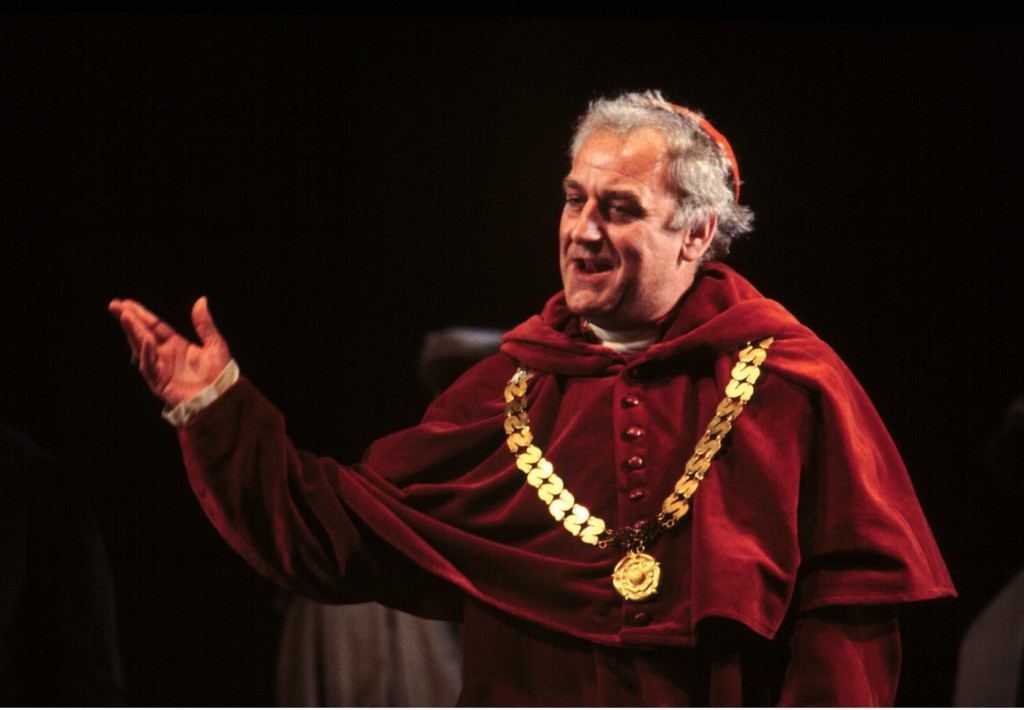
Photo Credit: Donald Cooper / Photostage
1984
John completed his season with the RSC, performing in The Time of Your Life, Twelfth Night and Henry VIII in Newcastle-upon-Tyne, in February, March and April.
Despite giving fine performances, John did not feel entirely at home with the RSC and declined to accompany the shows to the Barbican in London. The time spent with the company had, however, given him the opportunity to work with actors including Gemma Jones, Daniel Massey, Zoe Wanamaker and Richard Griffiths, all of whom would appear in episodes of Inspector Morse in upcoming years.
Coincidentally, Sheila Hancock had also performed with the RSC during the 1981 – 1982 season, and went on to become Artistic Director of the ‘Small Scale Tour’ for 1983-1984. The couple’s separate schedules both involved heavy workloads and time spent away from home.
In February 1984, the TV film Killer Waiting was broadcast, starring John in the role of ex-army Major Peter Hastings who is the target of a revenge plot by an unknown assailant. The film was part of a trilogy of thrillers. Brilliantly acted by John, it makes for chilling and disturbing viewing. Starring opposite John is Diane Keen, who had appeared in Sweeney! (1977)
John continued to perform in the theatre, moving on to work with the Theatre of Comedy Company. He took the role of Alfred Doolittle in George Bernard Shaw’s Pygmalion. Peter O’Toole played Professor Higgins, and the two actors relished working together. John gave an excellent portrayal of the working-class Doolittle. Pygmalion was performed at the Haymarket Theatre in Leicester from April to May, and at the Shaftesbury Theatre, London, from May.
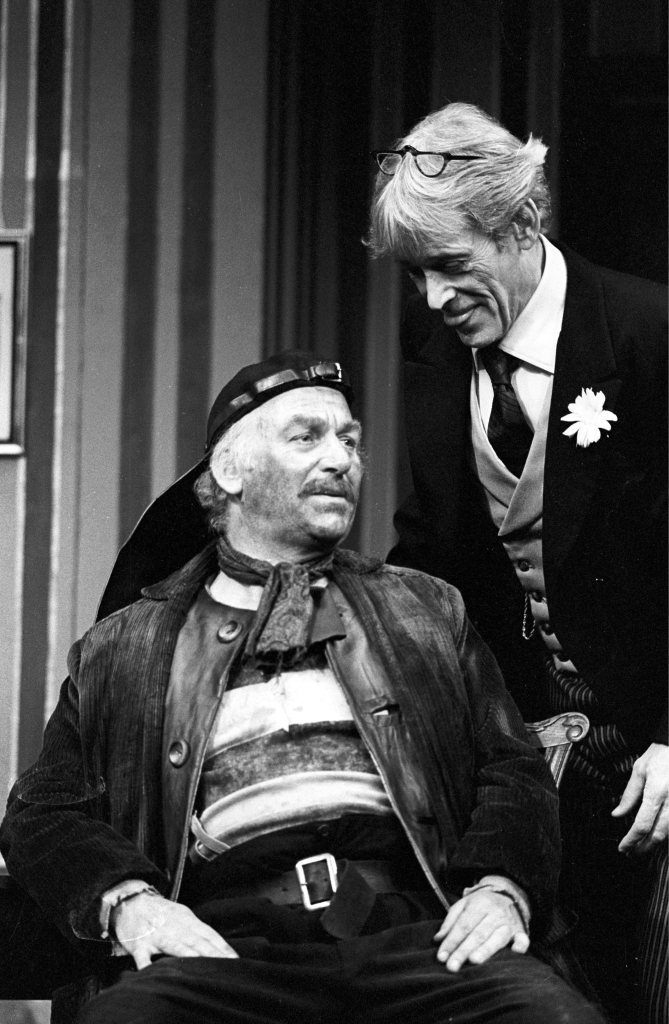
Photo Credit: Conrad Blakemore / ArenaPAL; http://www.arenapal.com
John travelled to Northern Ireland for filming of the TV play We’ll Support You Evermore, filmed from late August to the end of September. This play by Douglas Livingstone followed a father determined to find out the truth surrounding the killing of his son, a British soldier in Northern Ireland. John found himself deeply affected by the story and by the conditions and conflict in Belfast at the time.
The television series Mitch was finally televised in the Autumn of this year. John was also seen on television in a BBC production of Shakespeare’s The Life and Death of King John, playing the role of Hubert de Burgh.
1985
Along with Sheila, John took part in a one-off variety performance to raise funds for Save The Children and Oxfam, to relieve suffering caused by the drought and famine in East Africa. The show, Where There’s a Will, was presented by the RSC at the Barbican Theatre, London, on 17 March 1985. John Thaw, Sheila Hancock and Joe Melia performed “Parlato in Italiano” by David Monico.
In a job somewhat different to his usual projects, John was the presenter of a series of customer service training videos for the Austin Rover car company. Austin Rover: Who Cares Wins – The Key to Success was created for its employees. A crew of his fellow actors portrayed various customer service scenarios at the Austin Rover garage. It’s gripping stuff (!)
John’s second role in a television sitcom was far removed from his dishevelled villain Stan in Thick as Thieves. Middle-class, middle-aged Henry Willows is less than happy to have his orderly life disturbed by the return of his teenage son, played by Reece Dinsdale. John reportedly found the task of taking on the lead in a TV sitcom to be a frightening experience; not helped by the fact that it was performed in front of a studio audience. This did not affect the quality of his performance and he demonstrates a gift for comedy in the series. Home to Roost debuted on 19 April 1985. The following year, writer Eric Chappell was honoured with a Pye Television Award for writing the Best Male Comedy Role. Congratulations were also given to John for his portrayal of Henry Willows.
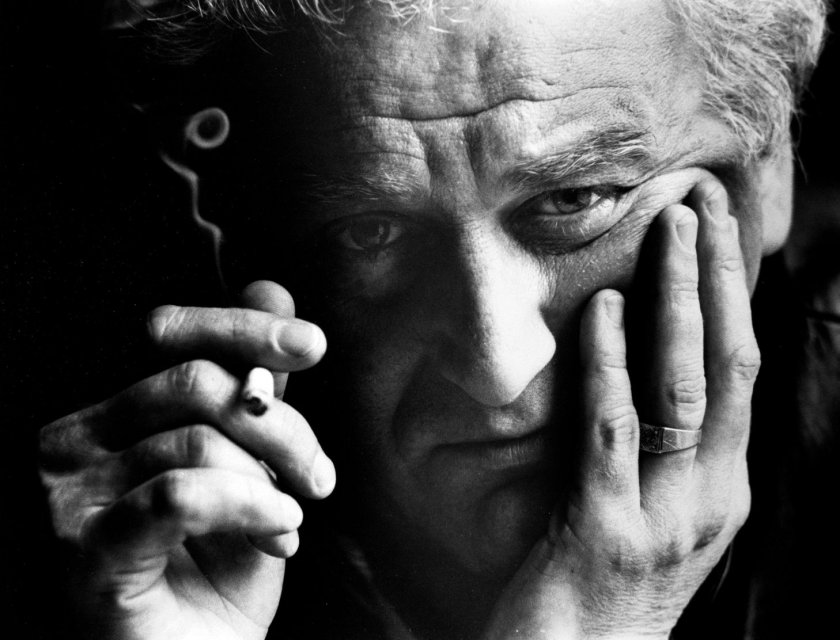
Credit: BRIAN HARRIS / Alamy Stock Photo
Sadly, as Sheila Hancock discusses in The Two of Us, John had become prone to bouts of depression and heavy drinking during this time (p. 193). This was to become an ongoing struggle during the next few years. There were, however, enjoyable times as well, such as time spent taking picnics together.
In July, the TV play We’ll Support You Evermore was broadcast.
Further theatre roles for John included a short run of Charles Dyer’s Staircase, performed at the Palace Theatre in Southend on Sea. Peter O’Toole, who had worked with John in Pygmalion, had turned down John’s entreaty to join him in the play, and John found himself playing opposite the playwright Charles Dyer himself in this comedy about the relationship between a gay couple who own a barber shop in 1960s London. Unfortunately, as Sheila Hancock remembers, “the play was not a success,” ( p. 191).
Also with the Theatre of Comedy Company, John on took the role of George Pigden in Ray Cooney’s farce Two Into One for its run of performances at the Royal Alexandra Theatre in Toronto, requiring another trip abroad. He went on to perform in this role during the final months of the production at the Shaftesbury Theatre in London, from 23 December until February the following year.

According to the authors of John Thaw: The Biography, it was during the run of Two Into One that John received a fateful phone call suggesting the role of Chief Inspector Morse in a planned adaptation of Colin Dexter’s popular detective stories. (Hildred, S., and Ewbank. T.). It was Ted Childs, now Head of Drama at Central TV, who had thought of John for the role, having worked with him previously on The Sweeney. Childs recognised that the casting of the character of Morse would be crucial. “In the wrong hands it could have been a tedious portrayal. But John is able to make the character appealing” (Hildred, S., and Ewbank. T.).
1986
A very busy year for John! Sheila Hancock, meanwhile, was also occupied with a heavy schedule, this time working with the National Theatre from 1985 – 1986, both as actor and director.
Two Into One continued to run at the Shaftesbury Theatre until 15 February.
John returned to Leeds to film the second series of Home to Roost in April and May. This would be broadcast from 5 September to 17 October later this year.
Filming for Inspector Morse then began in the summer. Its two-hour format, new and innovative at the time, made each ‘episode’ the equivalent of a film. The first series of three episodes would be shown the following year.
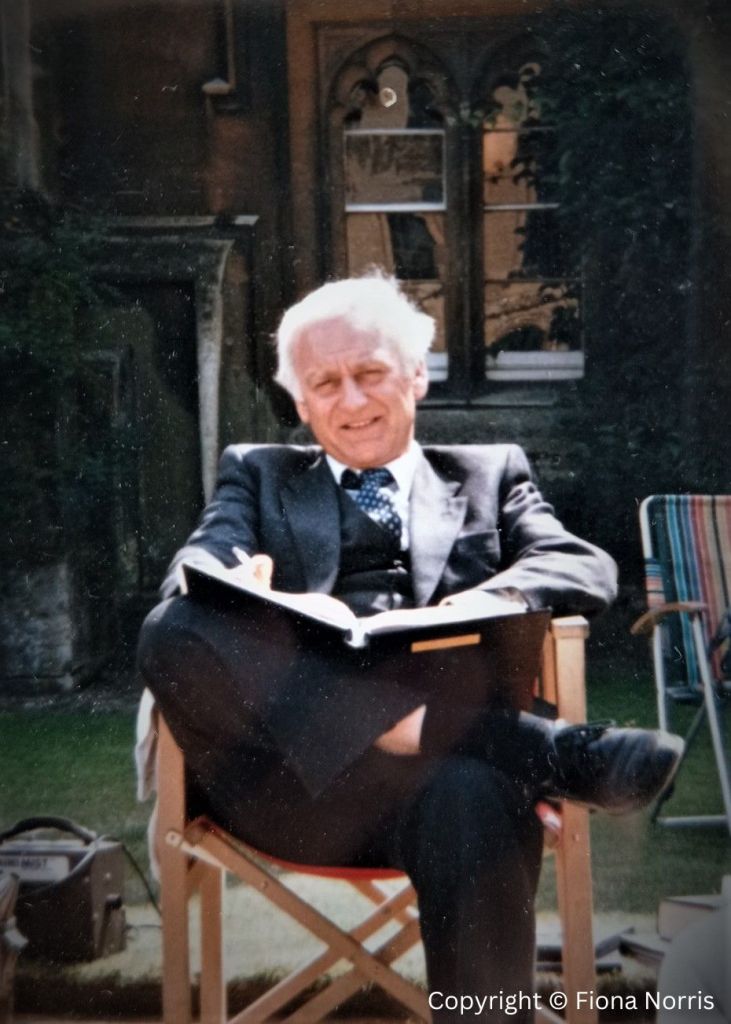
When filming finished on Inspector Morse, John was off to Zimbabwe to take part in filming of the movie Cry Freedom. He had accepted the role of Jimmy Kruger, the South African Minister of Police. The film portrays the friendship between Donald Woods and anti-apartheid activist Steve Biko, against the backdrop of apartheid South Africa. It was to be released the following year.
In contrast to the big-budget Cry Freedom filmed in Africa, John’s second cinematic role this year was in Business as Usual, filmed in Liverpool in November. Written and directed by Lezli-An Barrett, the film was based on a real-life industrial relations dispute and sexual harassment case. Glenda Jackson was cast in the starring role, with John playing opposite in the role of her husband.
1987
The first episode of Inspector Morse, “The Dead of Jericho”, aired on 6 January 1987. “The Silent World of Nicholas Quinn” was shown on 13 January, and “Service of All the Dead” on 20 January.
Kevin Whately and John Thaw during filming in Oxford.
John was seen on cinema screens as Business As Usual was screened in September, and Richard Attenborough’s film Cry Freedom was released in the UK and US in November. John’s portrayal of Kruger earned John a BAFTA nomination at the 1988 Film Awards.
On television, John could be seen again in a variety of roles. A third series of Home to Roost entertained audiences from the end of October through November and December. The only Christmas special made for the series, “Family Ties”, was shown on 27 December.
The Inspector Morse episode “The Wolvercote Tongue”, the first episode of the second series, aired on Christmas Day in the UK. The series was to continue the following March.
In the Sherlock Holmes TV film The Sign of Four starring Jeremy Brett, John took the role of the one-legged villain Jonathan Small. It was broadcast on 29 December 1987.
Although John’s career was at a new level of success, he was struggling with depression and alcoholism at this time. He was unable to cope when Sheila was diagnosed with breast cancer, and their marriage was under such strain that Sheila was to move out. The couple remained in close contact.
1988
John began the New Year with a trip to the USA to publicise Inspector Morse, before returning home to start rehearsals for a production of Arthur Miller’s play All My Sons. It was performed in John’s home town of Manchester, at the Royal Exchange Theatre, running 25 February 1988 to 9 April 1988. John gave a stunning performance in the lead role of Joe Keller. As Sheila notes, “At the final curtain there was a long silence before the applause started. It is the greatest compliment an audience can pay an actor: to be so moved and involved that it is hard to come back into the real world” (p. 213).
Inspector Morse returned to television screens with the series-two episode “Last Seen Wearing” broadcast on 8 March. “The Settling of the Sun” and “Last Bus to Woodstock” followed on the 15th and 22nd March.
The success of Inspector Morse had made John even more of a household name than he had been during the run of The Sweeney. He disliked the constant attention this brought.
1989
The third series of Inspector Morse was broadcast from 4 January 1989 with the episode “Ghost in the Machine.” The following weeks, “The Last Enemy” and “Deceived By Flight” were shown. Series three closed with “The Secret of Bay 5B” on 25 January.
The fourth and final series Home to Roost was filmed this year in March and April. It would be shown much later in the year, running from December into the following January.
In the spring of this year, John and Sheila announced that they were back together, and in July, the TV Times published a double-page feature following the couple on a specially arranged holiday to Egypt. The pair clearly still adored each other. However, as was noted in the article, Sheila had kept a separate house in Hammersmith, saying it was good to have somewhere to “scuttle off to” if she had “had enough.” (Knowles, 1989).
John and Sheila attending a theatre performance together.
John gave another memorable performance, in the TV Film Bomber Harris, which was broadcast on the BBC on 3 September 1989. The film explored the decisions taken by Arthur Harris, the Commander of RAF Bomber Command during the Second World War. John once again demonstrated his gift for inhabiting the character he is called on to play, appearing almost unrecognisable from previous roles.
Meanwhile, filming had been completed on a fourth series of Inspector Morse, which would be shown the following January.
Next page: 1990s – 2002
References:
Hancock, S. (2004). The Two of Us: My Life with John Thaw. London: Bloomsbury Publishing.
Hildred, S. and Ewbank, T. (2012). John Thaw: The Biography. [Kindle]. London: Andre Deutsch.
Knowles, S. (1989). ‘Why I betrayed my role as wife and mother by Sheila Hancock’, TV Times, (15-21 July), pp.4-5.
Bibliography:
BBC Genome (2024). Programme Index: “JohnThaw”. Available at: https://genome.ch.bbc.co.uk/search/0/20?q=%22John+Thaw%22#top
Big Red Book. ‘This Is Your Life: John Thaw’. Big Red Book Celebrating television’s This Is Your Life. Available at: https://www.bigredbook.info/john_thaw.html
British Film Institute (2024). Collections Search: “John Thaw”. Available at: https://collections-search.bfi.org.uk/web/
Bishop, D. (2008). The Complete Inspector Morse. Third Edition: Revised and Updated. London: Reynolds & Hearn Ltd.
Dene (2010). ‘Home to Roost (continued’, The Story of Euston Films, 24 December 2010. Available at: https://eustonfilms.blogspot.com/2010/12/home-to-roost-continued.html
IMDb contributors (2024). ‘John Thaw’. IMDb. Available at: https://www.imdb.com/name/nm0857177/
Shakespeare Birthplace Trust, ‘RSC Performances’: John Thaw. Available at: https://collections.shakespeare.org.uk/search/rsc-performances/search/rsc_person:thaw-john
Wikipedia contributors (2024). ‘John Thaw’. Wikipedia, The Free Encyclopedia. Available at: https://en.wikipedia.org/wiki/John_Thaw
